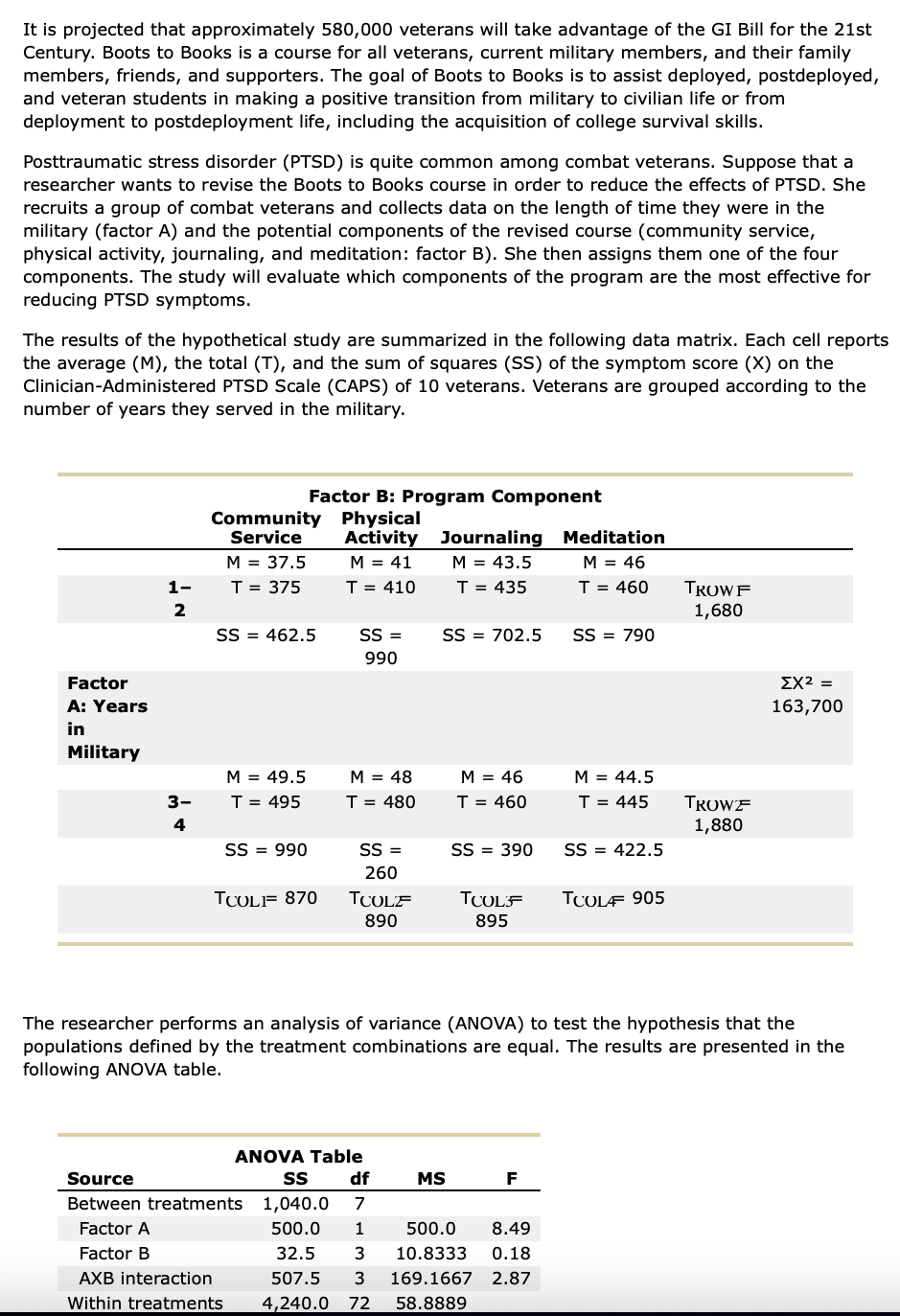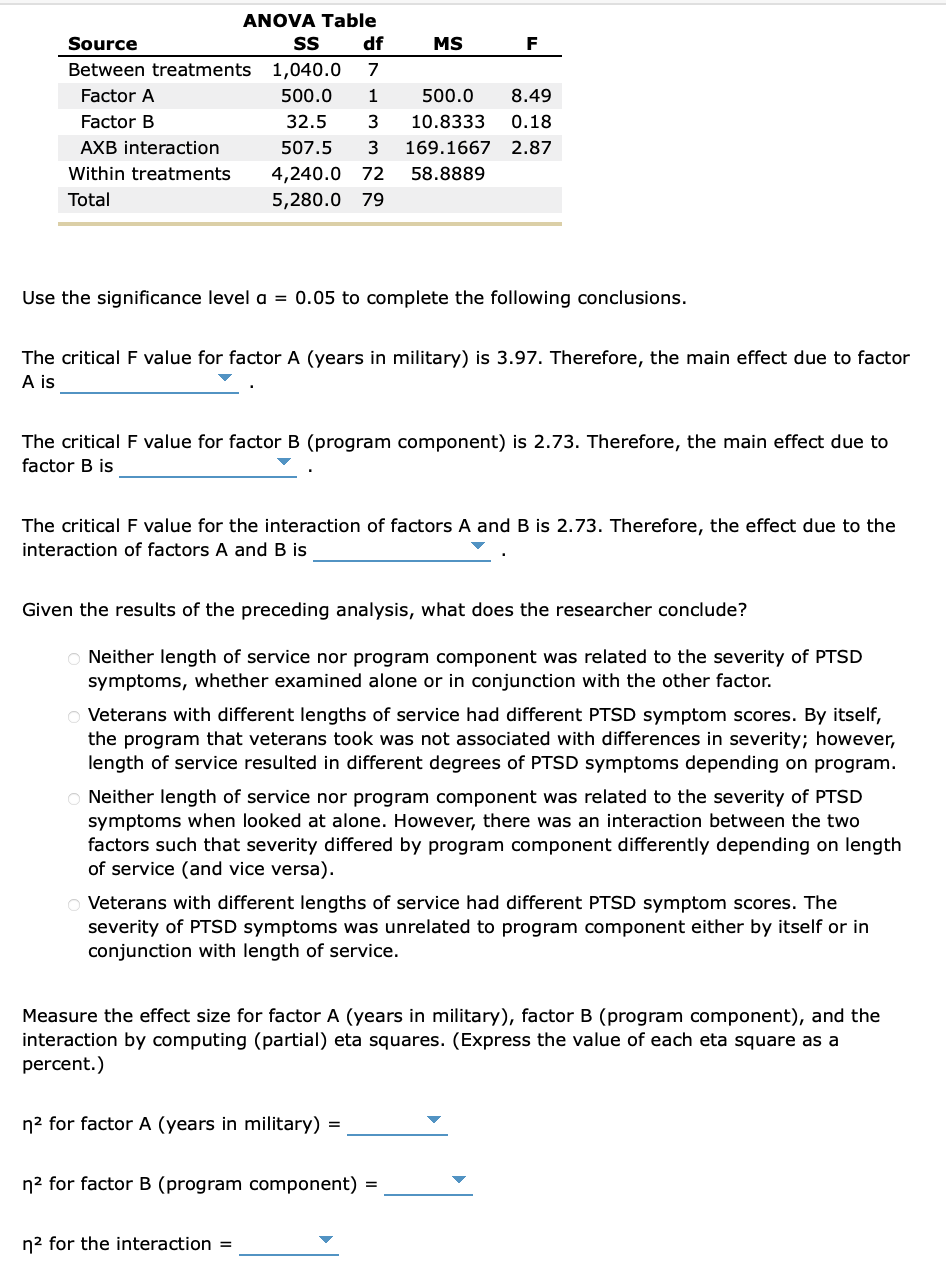It is projected that approximately 580,000 veterans will take advantage of the GI Bill for the 21st Century. Boots to Books is a course for all veterans, current military members, and their family members, friends, and supporters. The goal of Boots to Books is to assist deployed, postdeployed, and veteran students in making a positive transition from military to civilian life or from deployment to postdeployment life, including the acquisition of college survival skills. Posttraumatic stress disorder (PTSD) is quite common among combat veterans. Suppose that a researcher wants to revise the Boots to Books course in order to reduce the effects of PTSD. She recruits a group of combat veterans and collects data on the length of time they were in the military (factor A) and the potential components of the revised course (community service, physical activity, journaling, and meditation: factor B). She then assigns them one of the four components. The study will evaluate which components of the program are the most effective for reducing PTSD symptoms. The results of the hypothetical study are summarized in the following data matrix. Each cell reports the average (M), the total (T), and the sum of squares (SS) of the symptom score (X) on the Clinician-Administered PTSD Scale (CAPS) of 10 veterans. Veterans are grouped according to the number of years they served in the military.
It is projected that approximately 580,000 veterans will take advantage of the GI Bill for the 21st Century. Boots to Books is a course for all veterans, current military members, and their family members, friends, and supporters. The goal of Boots to Books is to assist deployed, postdeployed, and veteran students in making a positive transition from military to civilian life or from deployment to postdeployment life, including the acquisition of college survival skills. Posttraumatic stress disorder (PTSD) is quite common among combat veterans. Suppose that a researcher wants to revise the Boots to Books course in order to reduce the effects of PTSD. She recruits a group of combat veterans and collects data on the length of time they were in the military (factor A) and the potential components of the revised course (community service, physical activity, journaling, and meditation: factor B). She then assigns them one of the four components. The study will evaluate which components of the program are the most effective for reducing PTSD symptoms. The results of the hypothetical study are summarized in the following data matrix. Each cell reports the average (M), the total (T), and the sum of squares (SS) of the symptom score (X) on the Clinician-Administered PTSD Scale (CAPS) of 10 veterans. Veterans are grouped according to the number of years they served in the military.
MATLAB: An Introduction with Applications
6th Edition
ISBN:9781119256830
Author:Amos Gilat
Publisher:Amos Gilat
Chapter1: Starting With Matlab
Section: Chapter Questions
Problem 1P
Related questions
Question
Problem #12

Transcribed Image Text:It is projected that approximately 580,000 veterans will take advantage of the GI Bill for the 21st
Century. Boots to Books is a course for all veterans, current military members, and their family
members, friends, and supporters. The goal of Boots to Books is to assist deployed, postdeployed,
and veteran students in making a positive transition from military to civilian life or from
deployment to postdeployment life, including the acquisition of college survival skills.
Posttraumatic stress disorder (PTSD) is quite common among combat veterans. Suppose that a
researcher wants to revise the Boots to Books course in order to reduce the effects of PTSD. She
recruits a group of combat veterans and collects data on the length of time they were in the
military (factor A) and the potential components of the revised course (community service,
physical activity, journaling, and meditation: factor B). She then assigns them one of the four
components. The study will evaluate which components of the program are the most effective for
reducing PTSD symptoms.
The results of the hypothetical study are summarized in the following data matrix. Each cell reports
the average (M), the total (T), and the sum of squares (SS) of the symptom score (X) on the
Clinician-Administered PTSD Scale (CAPS) of 10 veterans. Veterans are grouped according to the
number of years they served in the military.
Factor
A: Years
in
Military
1-
2
3-
4
Community Physical
Service
Activity
M = 41
T = 410
M = 37.5
T = 375
SS = 462.5
M = 49.5
T = 495
Factor B: Program Component
SS = 990
AXB interaction
Within treatments
TCOLI= 870
Source
Between treatments
Factor A
Factor B
SS=
990
M = 48
T = 480
SS=
260
TCOLF
890
Journaling
M = 43.5
T = 435
SS=702.5
M = 46
T = 460
SS = 390
MS
TCOLF
895
ANOVA Table
ss
df
1,040.0 7
500.0 1
500.0
8.49
3 10.8333 0.18
32.5
507.5 3 169.1667 2.87
4,240.0 72
58.8889
Meditation
M = 46
T = 460
F
SS = 790
M = 44.5
T = 445
SS = 422.5
The researcher performs an analysis of variance (ANOVA) to test the hypothesis that the
populations defined by the treatment combinations are equal. The results are presented in the
following ANOVA table.
TCULF 905
TROWF
1,680
TROWE
1,880
ΣΧ2 =
163,700

Transcribed Image Text:ANOVA Table
SS
Source
df
Between treatments 1,040.0 7
Factor A
500.0 1
500.0
Factor B
32.5 3 10.8333
AXB interaction
507.5 3
4,240.0 72
Within treatments
Total
5,280.0 79
Use the significance level a = 0.05 to complete the following conclusions.
MS
The critical F value for factor A (years in military) is 3.97. Therefore, the main effect due to factor
A is
F
The critical F value for factor B (program component) is 2.73. Therefore, the main effect due to
factor B is
8.49
0.18
169.1667 2.87
58.8889
The critical F value for the interaction of factors A and B is 2.73. Therefore, the effect due to the
interaction of factors A and B is
Given the results of the preceding analysis, what does the researcher conclude?
O Neither length of service nor program component was related to the severity of PTSD
symptoms, whether examined alone or in conjunction with the other factor.
Veterans with different lengths of service had different PTSD symptom scores. By itself,
the program that veterans took was not associated with differences in severity; however,
length of service resulted in different degrees of PTSD symptoms depending on program.
ONeither length of service nor program component was related to the severity of PTSD
symptoms when looked at alone. However, there was an interaction between the two
factors such that severity differed by program component differently depending on length
of service (and vice versa).
n² for factor A (years in military)
Veterans with different lengths of service had different PTSD symptom scores. The
severity of PTSD symptoms was unrelated to program component either by itself or in
conjunction with length of service.
Measure the effect size for factor A (years in military), factor B (program component), and the
interaction by computing (partial) eta squares. (Express the value of each eta square as a
percent.)
=
n² for factor B (program component)
n² for the interaction =
Expert Solution
This question has been solved!
Explore an expertly crafted, step-by-step solution for a thorough understanding of key concepts.
This is a popular solution!
Trending now
This is a popular solution!
Step by step
Solved in 3 steps

Recommended textbooks for you

MATLAB: An Introduction with Applications
Statistics
ISBN:
9781119256830
Author:
Amos Gilat
Publisher:
John Wiley & Sons Inc

Probability and Statistics for Engineering and th…
Statistics
ISBN:
9781305251809
Author:
Jay L. Devore
Publisher:
Cengage Learning

Statistics for The Behavioral Sciences (MindTap C…
Statistics
ISBN:
9781305504912
Author:
Frederick J Gravetter, Larry B. Wallnau
Publisher:
Cengage Learning

MATLAB: An Introduction with Applications
Statistics
ISBN:
9781119256830
Author:
Amos Gilat
Publisher:
John Wiley & Sons Inc

Probability and Statistics for Engineering and th…
Statistics
ISBN:
9781305251809
Author:
Jay L. Devore
Publisher:
Cengage Learning

Statistics for The Behavioral Sciences (MindTap C…
Statistics
ISBN:
9781305504912
Author:
Frederick J Gravetter, Larry B. Wallnau
Publisher:
Cengage Learning

Elementary Statistics: Picturing the World (7th E…
Statistics
ISBN:
9780134683416
Author:
Ron Larson, Betsy Farber
Publisher:
PEARSON

The Basic Practice of Statistics
Statistics
ISBN:
9781319042578
Author:
David S. Moore, William I. Notz, Michael A. Fligner
Publisher:
W. H. Freeman

Introduction to the Practice of Statistics
Statistics
ISBN:
9781319013387
Author:
David S. Moore, George P. McCabe, Bruce A. Craig
Publisher:
W. H. Freeman